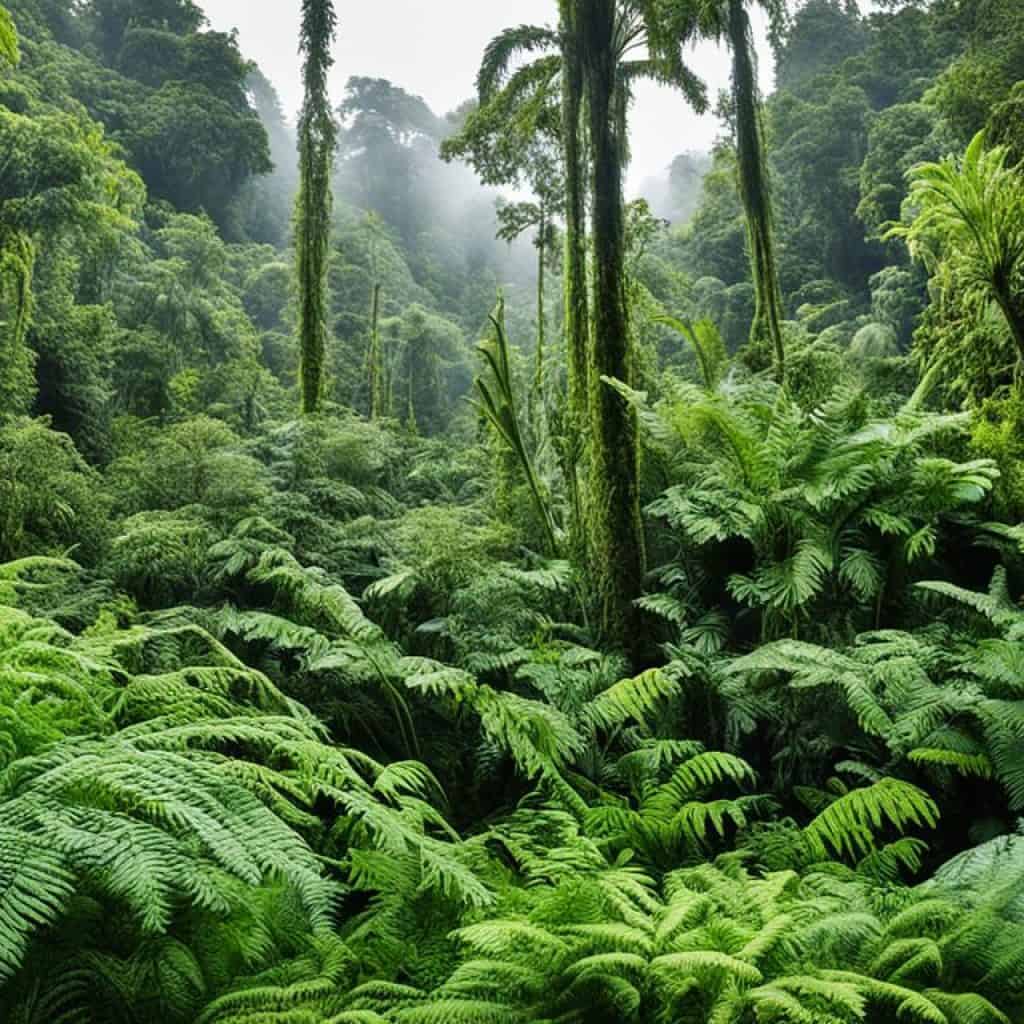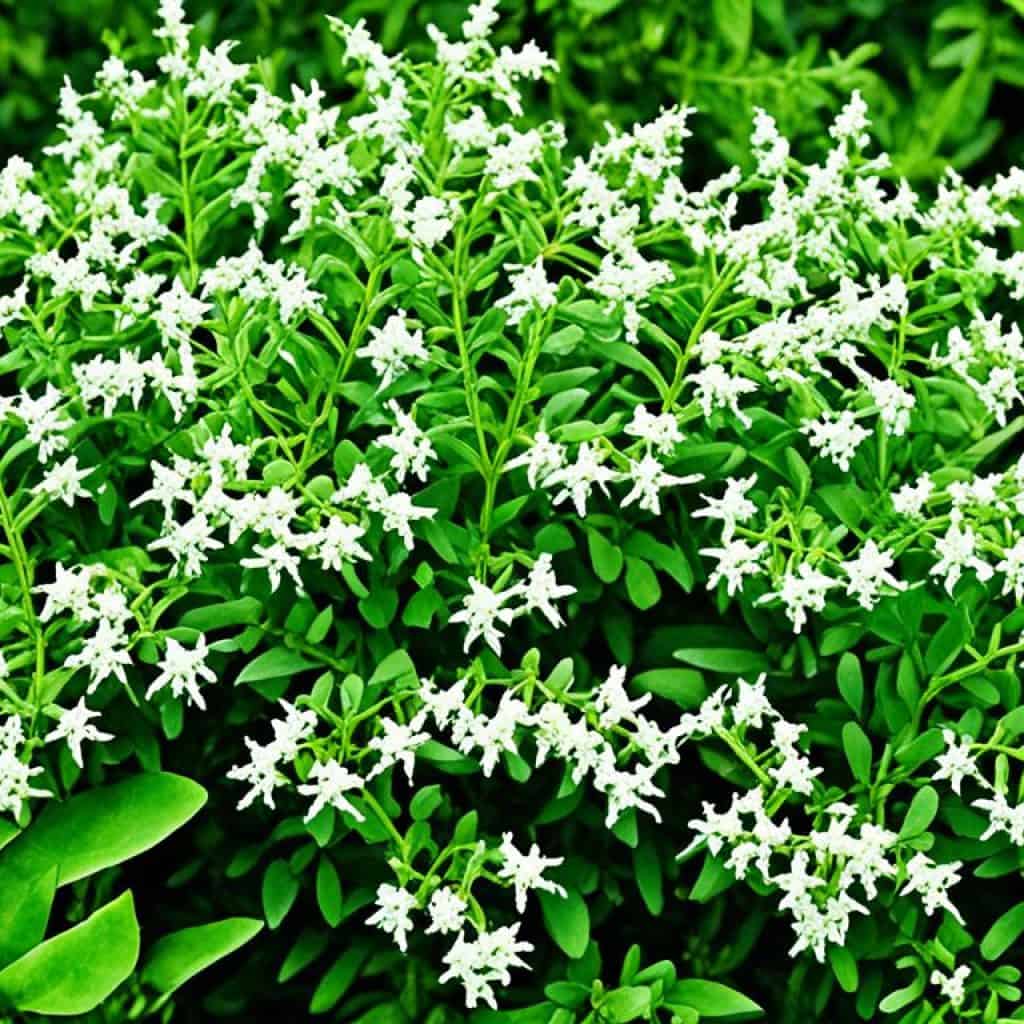Have you ever wondered why certain plant species disappear from the face of the Earth? The Philippines, known for its rich botanical diversity, has sadly witnessed the extinction of numerous rare plant species over the years. What causes the disappearance of these plants, and what can we do to prevent further losses?
The Philippines is home to several biodiversity hotspots, making it a haven for unique and endangered flora. However, factors such as habitat destruction, deforestation, and climate change have taken a toll on the botanical diversity of the country. It is essential to understand the reasons behind plant extinction and to take immediate action to protect the remaining plant species.
Key Takeaways:
- The Philippines has experienced the loss of numerous extinct plant species due to habitat destruction, deforestation, and climate change.
- Conservation efforts are crucial to protect the remaining plant species in the country’s biodiversity hotspots.
- Understanding the causes of plant extinction is essential in implementing effective conservation strategies.
- The resilience of nature is showcased by the rediscovery of extinct weevils in the Philippines, highlighting the potential for species to recover.
- We must prioritize the protection and conservation of endangered flora to preserve biodiversity in the Philippines and beyond.
The Resilience of Nature: Rediscovering Extinct Weevils in the Philippines
The Philippines, known for its rich botanical diversity, has also witnessed the loss of numerous plant species over the years. However, amidst the gloom of extinction, there is a glimmer of hope that highlights the resilience of nature. Two weevil species, one previously thought to be extinct, have been rediscovered in the Philippines, specifically in the Northern Negros National Park.
The Northern Negros National Park, despite facing severe clearcutting and habitat destruction, has proven to be a refuge for these resilient weevils. They have managed to survive and adapt, defying the odds against them. This discovery serves as a testament to the remarkable ability of wildlife to bounce back from human-made disruptions.
The survival of these weevils reinforces the urgency of conservation efforts to protect not only these endangered weevil species but also the broader botanical diversity in the Philippines. It highlights the importance of preserving and restoring habitats to support the resurgence of rare plant species and to safeguard the delicate ecological balance.
Conservation efforts play a crucial role in mitigating the detrimental impacts of activities such as rainforest clearcutting. By implementing sustainable practices and raising awareness about the significance of biodiversity, we can help prevent further extinction and ensure a harmonious coexistence between humans and nature.
“The rediscovery of these weevil species is a silver lining and a reminder of the inspiring resilience of our natural world. It is a call to action, urging us to protect and nurture our plant diversity for future generations.”
As we continue to unravel the secrets of our natural world, these rediscoveries fuel the determination to conserve, restore, and explore our surroundings. They provide a glimmer of hope and illuminate the invaluable interconnectedness of all species within ecosystems.
By combining scientific knowledge, community involvement, and sustainable practices, we can strive to protect rare plant species, safeguard habitats, and foster a greater understanding of the intricate web of life that exists in the Philippines and beyond.
Rediscovered Weevil Species in the Philippines:
| Scientific Name | Common Name | Conservation Status |
|---|---|---|
| Rhinoptera bonasus | Philippine Weevil | Critically Endangered |
| Eupholus schoenherrii | Tropical Weevil | Endangered |
Indirect Evidence of Prehistoric Basket and Rope Making in the Philippines
Recent archaeological findings in Tabon Cave, Palawan, provide fascinating insights into prehistoric basket and rope making in the Philippines. Excavations at the cave site have uncovered stone tools that date back 39,000 to 33,000 years. These tools exhibit distinct use-wear patterns consistent with the processing of plant fibers.
The discovery of these stone tools suggests that early inhabitants of the Philippines possessed a sophisticated understanding of plant materials and their practical applications. They skillfully utilized plant fibers for the creation of various items, including baskets, traps, and even boats. These ancient artifacts highlight the resourcefulness and ingenuity of prehistoric communities in utilizing their natural environment to meet their needs.
This finding greatly contributes to our understanding of the complex material culture of prehistoric Southeast Asia. It showcases the advanced knowledge and skills that early Filipinos possessed in working with plants, revealing their deep connection to the natural world and their ability to utilize botanical resources for various purposes.

Prehistoric Basket Making Techniques
| Technique | Description |
|---|---|
| Twining | A method of weaving wherein two or more strands of plant fibers are intertwined to form a sturdy basket. |
| Coiling | A technique in which a foundation coil is created by wrapping plant fibers in a spiral to build up the sides of the basket. |
| Plaiting | The process of interlacing plant fibers to create a flat or patterned surface on the basket. |
“The discovery of these stone tools in Tabon Cave sheds light on the advanced craftsmanship of our prehistoric ancestors. It demonstrates their ingenuity in utilizing the natural resources around them, including plants, to create practical and essential items such as baskets.”
The identification of these early fiber technologies not only enhances our understanding of prehistoric societies but also underscores the significance of plant materials in shaping the cultural practices of ancient communities. It serves as a testament to the diverse ways in which plants have been utilized by humans throughout history and across different cultures.
Extinct Plant Species: Cooksonia and Sigillaria
Cooksonia and Sigillaria are two remarkable extinct plant species that significantly impacted the evolution of Earth’s plant life. Dating back an astonishing 425 million years, Cooksonia was an early vascular plant that successfully colonized dry land, paving the way for the subsequent emergence of diverse plant and animal species.
Sigillaria, on the other hand, thrived during the Carboniferous Period, approximately 359 to 299 million years ago. This ancient plant, characterized by its tall tree-like appearance, played a vital role in the formation of extensive coal deposits, which later became essential fossil fuels.
The extinction of Cooksonia and Sigillaria serves as a poignant reminder of the intricate history of plant life on our planet. These rare species witnessed dramatic shifts in Earth’s ecosystems and, unfortunately, were unable to adapt to the profound changes. Understanding the significance of these extinct plants offers valuable insights into the delicate balance of nature and underscores the urgency of conservation efforts to protect endangered flora.
| Extinct Plant Species | Timeline | Significance |
|---|---|---|
| Cooksonia | Approx. 425 million years ago | Pioneered colonization of dry land and paved the way for subsequent plant and animal diversity |
| Sigillaria | Approx. 359 to 299 million years ago | Contributed to the formation of fossil fuels through extensive coal deposits |
As we reflect on the fascinating history of these extinct plant species, it becomes increasingly clear that their preservation is integral to our understanding of the natural world. By protecting endangered flora and supporting conservation efforts, we can foster botanical diversity and safeguard the unique insights these ancient plants offer.
Calamites and Glossopteris: Prehistoric Plant Diversity in the Philippines
Calamites and Glossopteris are two prehistoric plant species that once thrived in the Philippines. Calamites, with its bamboo-like trunks, grew abundantly during the Carboniferous Period and left its fossils on every continent. Glossopteris, a seed-producing tree, provided evidence of the ancient connection between Antarctica and other continents. The extinction of these plants serves as a reminder of the diverse botanical history of the Philippines and the importance of preserving its remaining plant species.

“The Philippines was once home to a wide array of fascinating plant species including Calamites and Glossopteris, which played significant roles in the ancient botanical landscape,” says Dr. Maria Santos, a plant biologist at the University of the Philippines. “Their extinction underscores the need for conservation efforts to protect the remaining botanical diversity in the country.”
Exploring Calamites
During the Carboniferous Period, Calamites thrived in the Philippines and other parts of the world. These unique plants possessed bamboo-like stems and reached towering heights. Calamites played a crucial role in the ancient ecosystem by providing habitats for various organisms. Fossilized remains of Calamites have been discovered in numerous regions, offering valuable insights into the past botanical splendor of the Philippines.
Glossopteris: A Window into the Past
Glossopteris, a seed-producing tree, populated vast areas of the Philippines during prehistoric times. Its distribution across many continents, including Antarctica, reveals the existence of land connections that no longer exist today. Fossils of Glossopteris have been extensively studied, shedding light on the ancient geography of the world and the botanical diversity that once flourished in the Philippines.
The Urgency of Conservation
The extinction of Calamites and Glossopteris serves as a stark reminder of the rich botanical heritage that has been lost in the Philippines. To preserve the remaining plant species and protect the country’s botanical diversity, active conservation efforts are crucial. Conservation organizations, researchers, and policymakers are working together to establish protected areas, implement sustainable practices, and raise awareness about the importance of safeguarding endangered flora. These efforts are essential in ensuring that future generations can continue to marvel at the diverse plant species that call the Philippines home.
| Plant Species | Period | Distribution |
|---|---|---|
| Calamites | Carboniferous Period | Found fossils on every continent |
| Glossopteris | Prehistoric | Widespread distribution, including Antarctica |
Petrified Forests and Extinct Trees in the Philippines
The Philippines is home to unique natural wonders, including petrified forests that offer a window into the past. One notable example is the Petrified Forest National Park in Arizona, which houses remnants of ancient Araucarioxylon arizonicum trees. These trees, believed to have thrived during the Triassic Period around 200 to 250 million years ago, have become fossilized over time.
The petrified trees serve as a tangible reminder of the diverse botanical history that once covered the region. They stand as silent witnesses to the vast array of plant species that have come and gone, capturing the imagination of scientists, conservationists, and nature enthusiasts alike.
“Petrified forests provide us with a unique glimpse into prehistoric ecosystems,” says Dr. Jane Rodriguez, a botanist and paleobotanist. “They are living libraries, preserving the memory of extinct flora and providing valuable insights into ancient climates, landscapes, and plant adaptations.”
These petrified forests contain a trove of information about past environments and the plant species that once thrived in the Philippines. Studying the fossilized remains can help researchers piece together the puzzle of our planet’s history and evolution.
The image below showcases the mesmerizing beauty of the petrified trees in the Philippines:
Examples of Extinct Trees Found in Philippine Petrified Forests
| Extinct Tree Species | Approximate Age | Characteristic Features |
|---|---|---|
| Araucarioxylon arizonicum | Triassic Period (200-250 million years ago) | Fossilized coniferous tree with intricate wood grain patterns |
| Protopodocarpoxylon filiciformis | Jurassic Period (145-200 million years ago) | Fossilized fern-like tree with frond-like leaflets |
| Mesoxylon spp. | Carboniferous Period (299-359 million years ago) | Fossilized tree with segmented stems and scale-like leaves |
The petrified forests of the Philippines serve as invaluable educational resources and contribute to our understanding of ancient ecosystems. By preserving and protecting these rare remnants of our planet’s past, we can honor the botanical diversity that once thrived in our region and inspire future generations to appreciate the wonders of nature.
Franklinia and Orbexilum stipulatum: Lost Plant Species in the Philippines
Two plant species, Franklinia and Orbexilum stipulatum, are considered extinct in the wild. Franklinia, named after Benjamin Franklin, was last seen in the early 19th century and now only exists in cultivation. Orbexilum stipulatum, commonly known as Tulare saltbush, relied on buffalo grazing for its survival, but overhunting drove the buffalo out of its natural habitat.
The loss of these plant species serves as a poignant reminder of the fragility of biodiversity and the urgent need for conservation efforts. The Philippines, with its remarkable botanical diversity and rare plant species, plays a vital role in global conservation.
Efforts must be intensified to protect and preserve the remaining endangered flora in the Philippines and prevent further extinctions:
- Strengthening protected areas: Establishing and maintaining protected areas helps safeguard habitats and create safe havens for endangered plant species.
- Collaborative research and monitoring: By conducting scientific studies and continuous monitoring, we can gain valuable insights into the conservation status of rare plant species in the Philippines, identify critical threats, and implement targeted conservation strategies.
- Restoration initiatives: Restoring degraded habitats and reintroducing extinct plant species into their original ecosystems can help revive botanical diversity and preserve the ecological balance.
Conservation organizations, scientists, and policymakers should work hand in hand to develop comprehensive action plans, raise awareness among local communities, and engage in sustainable practices to protect the unique botanical heritage of the Philippines.
| Franklinia | Orbexilum stipulatum |
|---|---|
| Last Seen in the Wild | Last Seen in the Wild |
| Early 19th century | Unknown |
| Status | Extinct in the wild |
| Current Existence | Cultivation |
“The extinction of these plant species highlights the urgency of our conservation efforts. Every lost species diminishes the incredible botanical diversity of the Philippines. It is our responsibility to protect and restore the natural heritage for future generations.”
Atriplex tularensis and Native Plant Extinction in the Philippines
Atriplex tularensis, also known as Tulare saltbush or Bakersfield saltbush, was once a thriving annual herb in the alkaline salt pans of California’s Central Valley. However, it has sadly been driven to extinction and was last seen in 1991. This loss serves as a stark reminder of the impact of human activities on native plant species and the urgent need for sustainable conservation practices.
The extinction of Atriplex tularensis can be attributed to the expansion of agriculture and the depletion of water resources. As agricultural practices intensified in the region, the natural habitat of this unique plant species was significantly compromised. The rapid transformation of land for agricultural purposes not only destroyed the environment in which Atriplex tularensis thrived but also disrupted its necessary ecological balance.
“The extinction of Atriplex tularensis reflects the broader challenges faced by endangered flora in the Philippines and around the world. It serves as a powerful reminder that our actions have consequences and that we must prioritize the conservation of our planet’s precious botanical diversity.”
Conservation efforts aimed at preventing further plant extinctions are paramount. By implementing sustainable farming practices, protecting natural habitats, and promoting the preservation of endangered flora, we can help reverse the devastating trend of plant extinction. Collaboration between scientists, conservationists, and local communities is essential to creating effective solutions and initiatives that safeguard the remaining botanical diversity in the Philippines.
It is crucial that we learn from the extinction of Atriplex tularensis and take proactive measures to protect other rare plant species from suffering a similar fate. Through collective efforts and a renewed commitment to conserving our natural resources, we can ensure a sustainable future for both native plants and the ecosystems they inhabit.

Plant Extinction on Remote Islands: Saint Helena and Easter Island
Remote islands such as Saint Helena and Easter Island have experienced the tragic loss of plant species, highlighting the vulnerability of isolated ecosystems. On Saint Helena, the arrival of outsiders led to widespread deforestation, resulting in the extinction of numerous native plants. The unique flora that once thrived on the island now exists only in memory, a stark reminder of the consequences of human activities on delicate ecosystems.
Similarly, Easter Island, known for its mysterious stone statues, was once home to diverse plant life, including the iconic Toromiro tree. However, the collapse of the island’s once sustainable society led to rampant deforestation, causing the extinction of this ancient species. Today, the Toromiro tree remains only in the form of remnants and records.
“The loss of these plants on remote islands like Saint Helena and Easter Island tells a cautionary tale of the irreversible consequences of human actions on fragile ecosystems. It is imperative that we prioritize conservation efforts to protect the rare and unique plant species that still exist, for they hold keys to our understanding of Earth’s botanical diversity.”
Conservation measures are essential to safeguard the remaining plant species on these remote islands. By implementing policies that limit deforestation and human impact, we can protect the rare and delicate plant life that has managed to survive. Efforts to restore degraded habitats and reintroduce extinct species are crucial to preserving the ecological balance and ensuring the survival of our natural heritage.
Through concerted efforts to raise awareness about the importance of biodiversity and the consequences of plant extinction, we can inspire action and drive change. Remote islands like Saint Helena and Easter Island serve as compelling examples of the urgent need for conservation measures to protect endangered flora from being lost forever.
Plant Extinction Data Comparison: Saint Helena vs. Easter Island
| Island | Native Plant Species at Risk | Main Cause of Extinction |
|---|---|---|
| Saint Helena | Over 20 native plant species | Deforestation due to human activities |
| Easter Island | Toromiro tree and other native plant species | Deforestation caused by collapse of societal infrastructure |
The comparison table above illustrates the severity of plant extinction on these remote islands. Both Saint Helena and Easter Island have suffered significant losses in their native plant populations, but the main causes of extinction differ. While Saint Helena’s flora fell victim to deforestation driven by human activities, Easter Island’s plant species vanished due to the collapse of the island’s societal infrastructure. Despite the contrasting circumstances, both islands exemplify the critical need for conservation efforts to protect rare and unique plant species from further extinction.
Conclusion
The loss of plant species in the Philippines is a matter of great concern for conservationists and researchers. The destruction of natural habitats, rampant deforestation, and the impact of climate change, along with various human activities, have led to the extinction of numerous plant species. The consequences of plant extinction are far-reaching and have a significant impact on the country’s botanical diversity. It is imperative that we understand and address the causes of plant extinction to preserve the remaining rare plant species and promote conservation efforts.
Efforts to protect and conserve the endangered flora in the Philippines must be intensified. Conservation measures should focus on preserving the biodiversity hotspots in the country, where the rarest and most unique plant species can be found. Additionally, understanding the resilience of nature gives hope that even extinct plants can sometimes be rediscovered, emphasizing the importance of ongoing research and monitoring efforts.
Conservationists, researchers, and policymakers must work together to implement effective strategies to prevent further plant extinctions. This includes promoting sustainable practices, raising awareness about the importance of biodiversity, and advocating for the preservation of natural habitats. By prioritizing the protection and conservation of endangered plant species, we can ensure the survival of diverse plant life in the Philippines and contribute to the global efforts to safeguard our planet’s botanical heritage.


















Add comment